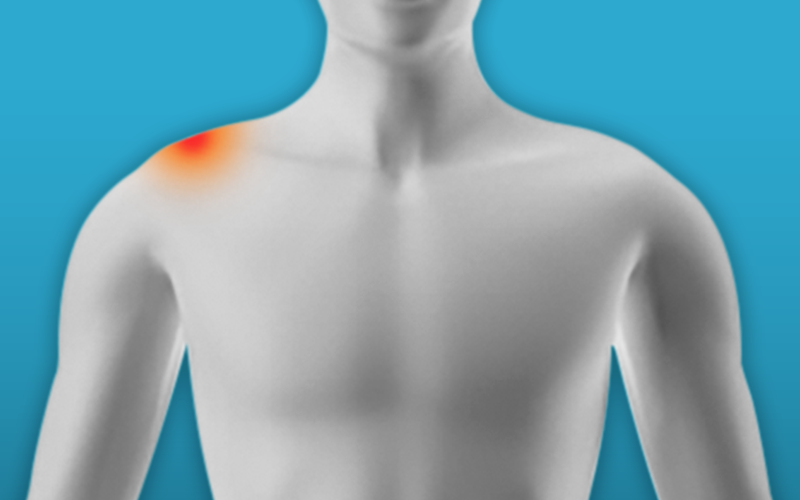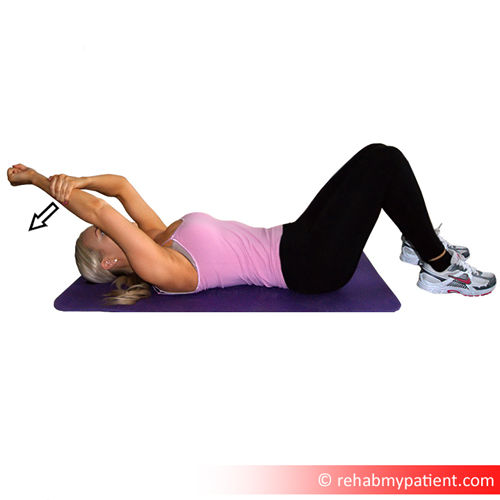
Acromioclavicular joint (ACJ) pain
What is it?
Acromioclavicular joint (ACJ) pain occurs where the collar (clavicle) bone meets the shoulder blade (scapula).
The shoulder joint – front view of a left shoulder
- Clavicle (collar bone)
- 1st rib
- Acromion (tip of shoulder blade)
- Coracoid process
- Head of humerus (ball of joint)
- Gleniod fossa (socketof joint)

Pain in this joint can occur if you carry out a lot of activities that require you to lift your arms above your head.
Making changes to the amount of overhead activities you do can ease the pain. Painkillers can manage the symptoms, but seek advice from your GP or pharmacist before taking. If the pain is persistent, physiotherapy will also help.
If you have injured your ACJ by falling on your shoulder or similar trauma please seek advice from a medical professional such as your GP, Physiotherapist or Emergency Dept. It may be necessary to protect the injury by wearing a sling in the first few weeks. If you don’t have access to a sling you can click here to learn how to make your own.
In some case you may benefit from having an x-ray within the pain locality.
How to manage Acromioclavicular joint pain
Rest or Activity modification
This does not mean you stop moving or using your shoulder altogether. It means reducing activities over your head or behind your back as this can help to reduce the irritation in your shoulder.
Ice therapy
May be helpful to relieve pain. Place a damp cloth on your shoulder and then place and icepack (or bag of frozen peas) over the top of this. Leave it on for 10-15 minutes and use up to 3 times a day.
- People should be cautious using these treatments if they have altered skin sensation or circulatory problems.
- Check the skin regularly
- Stop if there is excessive pain, numbness or tingling
- Do not put ice directly on to the skin as this may cause a burn.
Exercises
These are commonly advised with the aim of regaining movement in your shoulder and decreasing pain. For most benefit, it is important to do the exercises regularly, the exercises may be uncomfortable to perform but the discomfort should wear off within 30 minutes of stopping. If the discomfort lasts for longer than this or if the pain gets worse, stop exercising and seek advice from your doctor or physiotherapist. See below for examples of exercises to try. Do as many repetitions as you feel comfortable with, and then gradually build up.
Pendulum Exercises
Stand leaning on a table supporting your body weight with the other hand. Let your affected arm hang, relaxed, straight down.
– Swing your arm forwards and backwards 30 seconds
– Swing your arm sideways, left and right
– Swing your arm in a circle

Shoulder Rolls
In sitting or standing, roll your shoulders backwards and forwards

Assisted Arm Raises
Lie on your back, on your bed, with your elbows bent. Hold one wrist with your other hand. Lift the affected arm, assisting with your other hand.
If this is easy do not use the other hand to help

Table Slides
Sit or stand. Place your hands on a table. Slide your hands along the table as far as you can without lifting your shoulders

Shoulder Raises
Walking your hand up the wall
Stand facing a wall. ‘Walk’ your fingers up the wall as high as possible. Reverse down in the same way.
As this gets easier use the wall less and less

Forwards
When walking your hand up the wall is easy try raising your affected arm without support

Sideways (assisted)
Stand and grip one end of a stick with the affected arm. Lift your arm as high as possible, assist by pushing with the other hand.
If you can do this comfortably do this action without the stick (See exercise to the right)

Sideways (non assisted)
When the above exercise is easy do a similar with movement without the assistance. Stand or sit, with arms by your sides.
Lift your arm to the side and up with the thumb leading the movement. Lower the arm back to the starting position.

Strengthening Exercises
Isometric Exercises – external rotation
Stand or sit. Hold your upper arm close to your body with your elbow at a right angle. Try to move your hand outward, resisting the movement with the other hand. There should be no movement.
Hold for 10 seconds and repeat 3 times.

Isometric Exercises – internal rotation
Stand with your arm close to your side and your elbow at a right angle. Push the palm of your hand against the other hand. There should be no movement.
Hold for 10 secs and repeat 3 times.

Posture – How you hold your head and shoulders is important. If the head and shoulder blade are pushed forward (for example, hunched or rounded shoulders), this position forces the shoulder muscles to work in an abnormal way. This can then lead to a reduction in the mechanical efficiency of the shoulder during movement and pain around the acromioclavicular joint
Simple painkillers
Painkillers like paracetamol will ease the pain, but need to be taken regularly in order to control the pain. Always follow the instructions on the packet.
Anti-inflammatories like ibuprofen can help with swelling, and therefore help you move more freely. Follow the instructions on the packet and discuss using them safely with a pharmacist, especially if you have any underlying health conditions
However, you should not take ibuprofen for 48 hours after an initial injury as it may slow down healing.
Up to date guidelines can be found on the NHS website:
Other medicines can help to reduce inflammation, swelling and pain. You should discuss this with your GP if the simple pain relief advice does not help or if you are needing to take ibuprofen for more than 10 days.
Physiotherapy
If you find that you are not improving, some advice or treatment from a physiotherapist can be helpful in managing shoulder pain. Click here to self-refer to a physiotherapist.
How to prevent and manage future symptoms?
Avoid excessive overhead activities and change position regularly.
